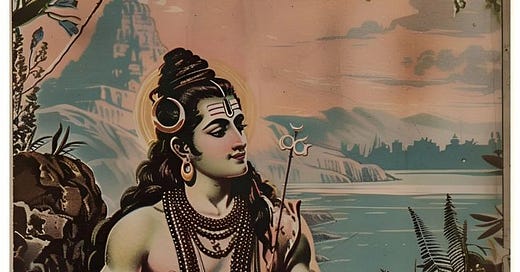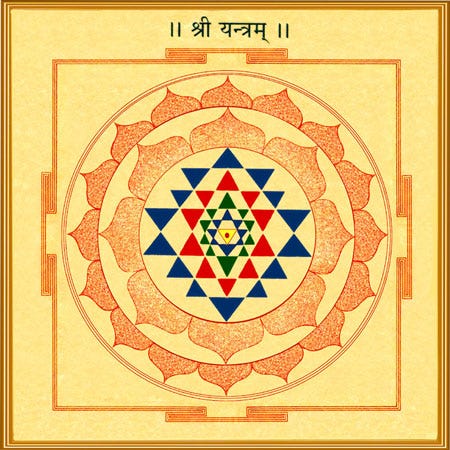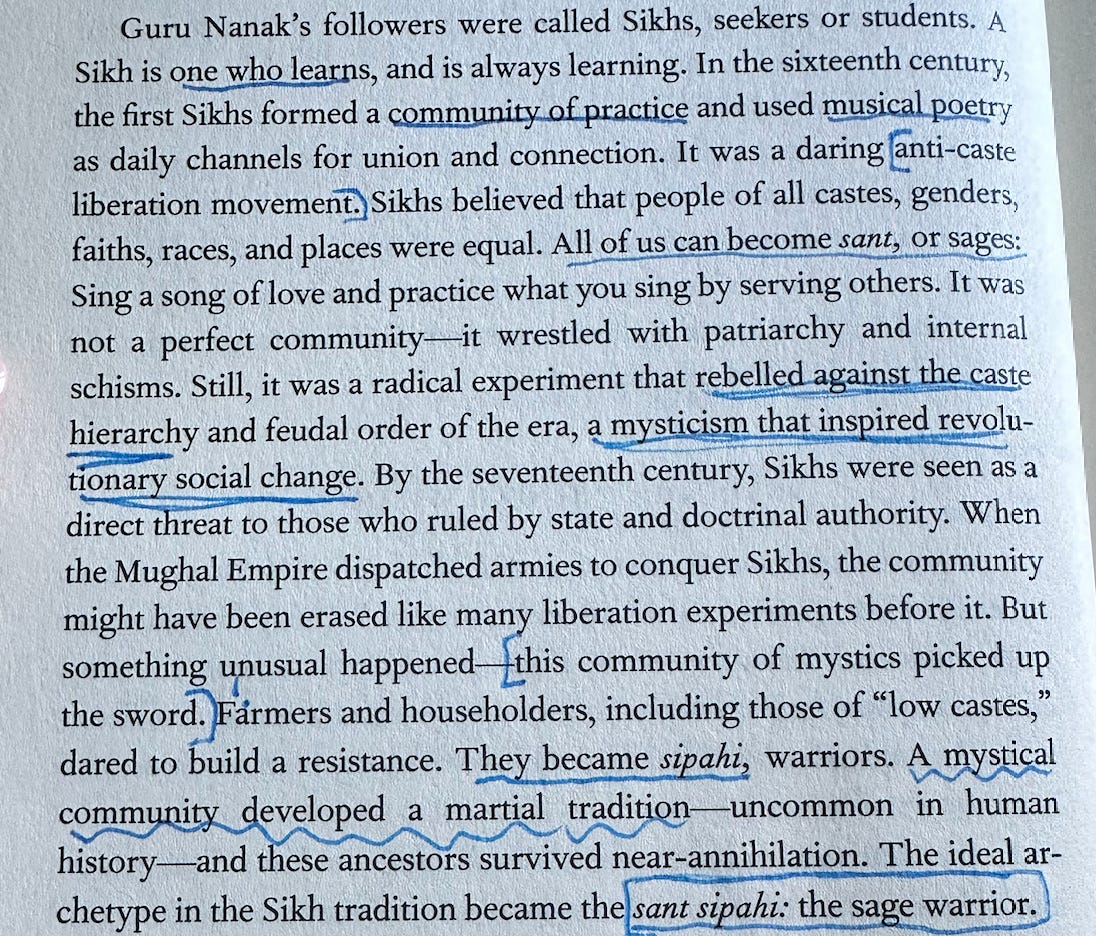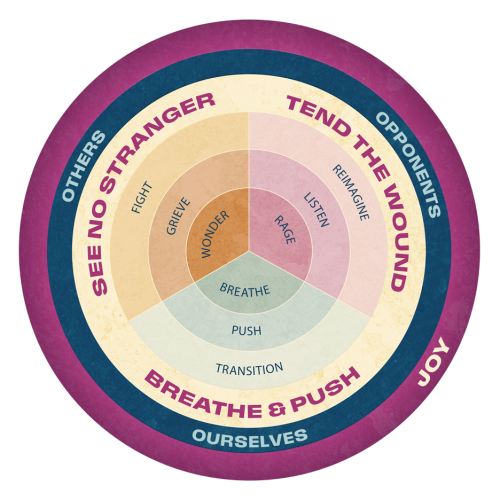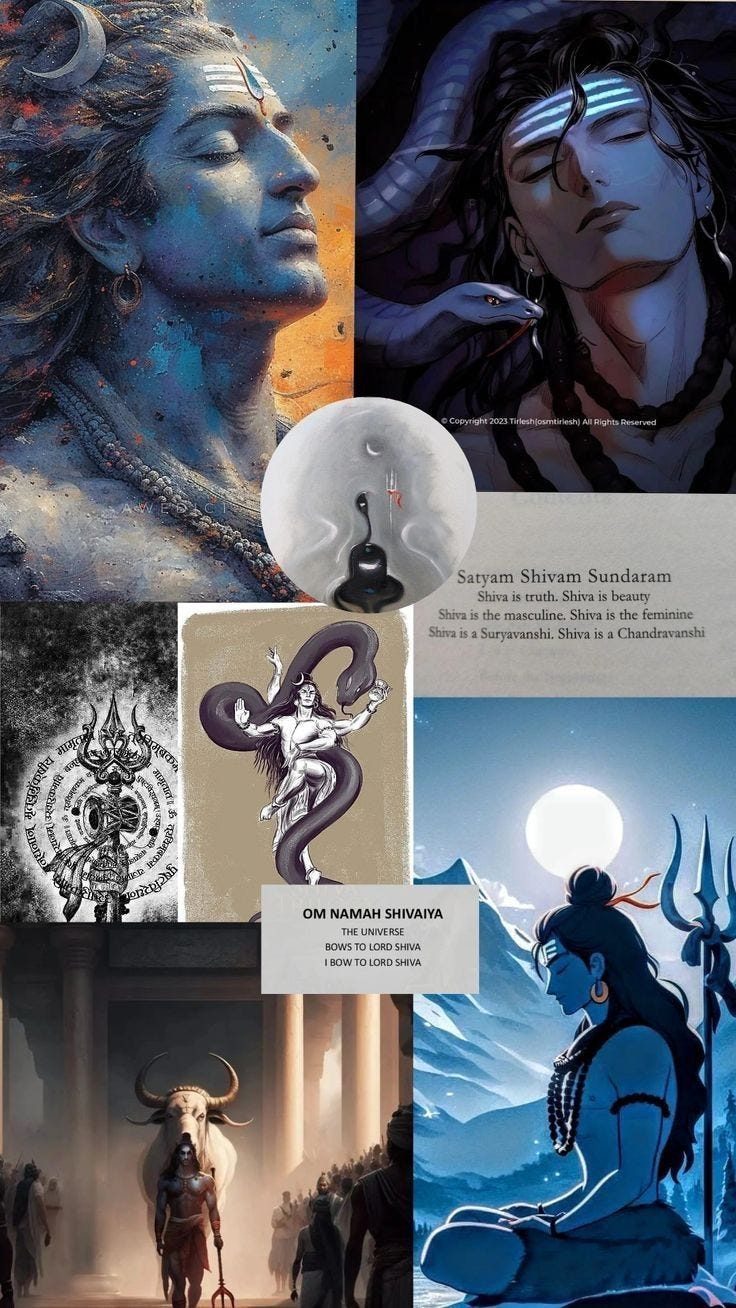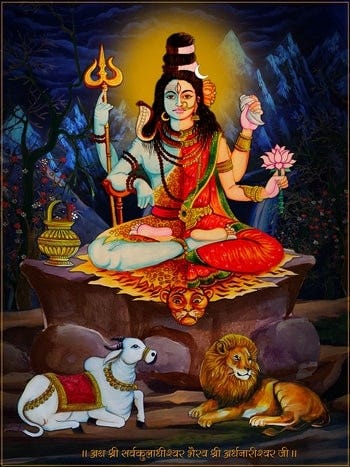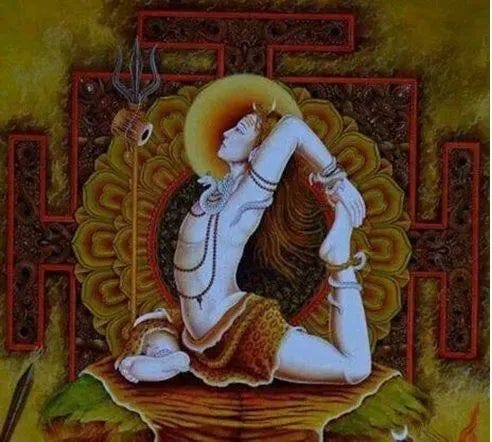Part 1: In Search of the Divine Masculine
For the last year this project has been alive, it has been a place for reflecting on the many faces of the Dark Goddess and her relvance for our modern condition. We’ve explored her experiential teachings through examining history, mythology, culture, psychology, personal story, and ritual.
What I have spent a lot less time here exploring is her divine counterpart 👀
This is a Yantra, a mystical geometric design and foundational Tantric tool used in meditation, a visual portal through which to calm the mind. They have deep spiritual significance and represent the energetic order of the Universe. Each Yantra is a unique combination of the simple shapes - the dot, triangle, circle, square, and lotus. Notice the harmony between line and curve, angles and circles, form and formless. These symbols, like the Yin Yang, are representations of the eternal dance of polarities. Learn more about Yantras.
Out of 40-some issues, I’ve only explored masculinity three times here, two of which have been explicitly critical of how modern concepts of masculinity uphold patriarchal violence:
While I’ve stated that engaging with the Dark Goddess is requisite work for all in the process of decolonization, I’ve not done such a good job of connecting these concepts to the people least likely to engage with this work.
It feels especially critical for us to understand, heal, and embody the divine masculine as much as the divine feminine in these times where man-made violence and destruction seems to be proliferating in scale and depravity.
So over a three-part series, I’ll be sharing insights from my own search for and understanding of the divine masculine. Today’s Part 1 examines the wisdom of the divine masculine in spiritual traditions, Part 2 will explore the battle-tested strategy of social movements, and in Part 3 I’ll share how the divine masculine has been dancing through my own life and spiritual practice.
A Decolonial Feminist Approach to the Divine Masculine
We know that religious, spiritual, and yogic traditions have been deeply patriarchal for millenia. These traditions have historically centered male authority figures and told stories that venerate supreme male deities, while women and gender non-conforming people were relegated to subordinate, marginal, or even villainous roles.
The spiritual teachings and history may have had more nondual and feminist shapes in their ancient, mystical origins, but what dominates today as divine teachings in fact been shaped by the political agendas of male-dominant leadership of religious institutions over centuries.
So engaging with the divine masculine in a patriarchal spiritual context is complex and challenging. On the one hand, it requires confronting the historical entanglement of masculinity with domination, violence, and control where war and conquest have been sanctified. On the other hand, the divine masculine, like the divine feminine, holds liberatory potential when we relate to him through a decolonial feminist lens. For years I rejected the masculine and patriarchal teachings in entirety, but I’ve recently realized that when approached with a nondual and feminist lens, these teachings are requisite to practicing social justice.
Today I offer three vignettes that imagine a version of the divine masculine not tied to aggression or oppression, but instead embodying qualities such as protection discipline, wisdom, and strategic leadership in service of collective liberation.
1. Revolutionary Love - the Sage Warrior from the Sikh Tradition
2. Shiva as Shakti’s Consort and Father of Yoga
3. Christ Consciousness & Feminist Christian Theology
Revolutionary Love - The Sage Warrior from the Sikh Tradition
“How do we find the wisdom to envision a new world and the courage to fight for it? How do we survive apocalyptic times? In a world on fire, how do we find love and joy?” - Valerie Kaur
I got the chance to attend one of the stops on Valerie Kaur’s Revolutionary Love tour. In Grace Lee Bogg’s home in Detroit, we gathered to listen to music, hear epic stories and poetry, and engage in dialogue over food. Watch this ~1 min clip to get a taste of the Revolutionary Love expeirence.
On this tour and in her new book Sage Warrior, Valerie offers feminist retellings of the first Sikh ancestors and shares the nourishing wisdom they offer.
The Sikh tradition emerged in the 15th century in the land of Punjab, which today spans both India and Pakistan. In a time rife with caste and conquest, Hindus and Muslims who sang of liberation met and mixed in Punjab. This is the context in which the Sikh tradition was born.
Sant Sipahi, the Sage Warrior is an apt archetype to embody in our turbulent times. Kaur writes,
“The Sage is someone who loves deeply. You cultivate wonder for others and the earth and wake to Oneness. You befriend the body - parts of the world, and parts of yourself. You practice pleasure through music, meditation, movement, and more as channels for awakening. You build sovereign space where you can find refuge and rest in wisdom within you.
The warrior is someone who fights for humanity, including your own. You access your agency and activate power. In the face of injustice, you harness rage and refuse to surrender your humanity. You join others to grieve together and alchemize pain into energy and action. You choose courage in the face of crisis. In doing so, you become victory. You embrace rebirth.”
The Sage Warrior is not an aggressor, but a protector and healer who fights with a love ethic. Kaur emphasizes that spiritual discipline can sharpen this protective energy, making service leadership more powerful, compassionate, and effective. For Kaur, the sage warrior is one who leads from a place of inner stillness, integrating both divine masculine and feminine energies to embody revolutionary love in practice.
Learn more about the compass framework here.
There’s so much I love about the Sikh tradition. Over Christmas last year, my extended family and I visited nearby Gurudwara serving thousands in the San Jose Bay Area. A large, diverse community gathered in the sprawling complex. Volunteers guided visitors, elders played with children outside, and devotees enjoyed day-long program of music and prayers in the temple. Large-scale paintings and display posters told the stories of the gurus and the women who have shaped Sikh history. We partook in the Langar, a distinctive element of the Sikh religious tradition. At every Sikh temple around the world, every single day, free cooked meals are served to all visitors, regardless of their social or religious background.

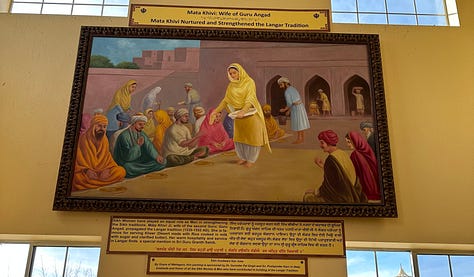
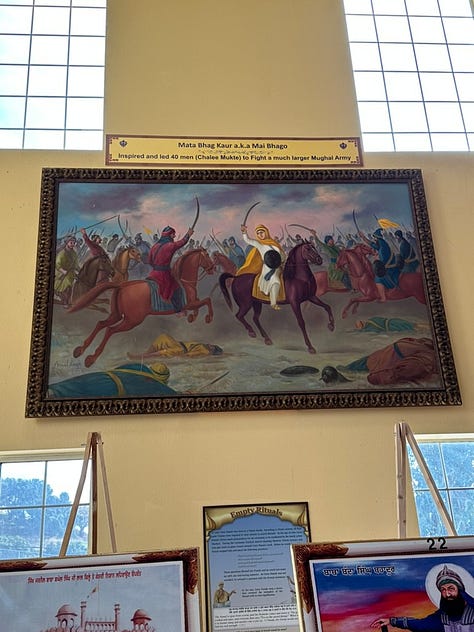
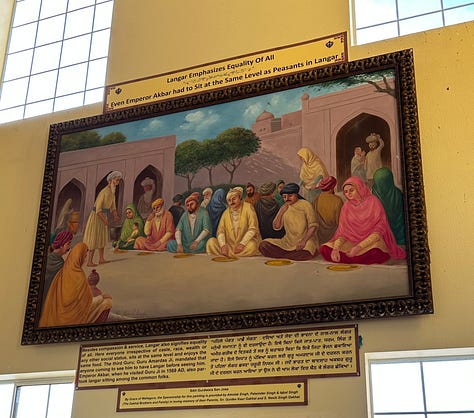


These experiences show that when gather in community with time-tested spiritual texts and traditions, we can we can incubate ways of being that pave the path to justice and liberation.
Shiva as Shakti’s Consort & Father of Yoga
We’ve explored in-depth here Kali and Durga. Kali, Durga, and Parvati are Shakti as triple goddess. Parvati represents the Maiden, Durga represents the Mother, and Kali is the crone.
Shiva is the divine masculine consort to the powerful and fierce Dark Goddess in her multitudinal forms. So it’s fair to say that Shiva is a deeply powerful and transformative being in his own right if he is the counterweight to these heavy-hitter goddesses.
Shiva and Parvati’s relationship are at the core of Hindu Tantric texts and teachings. In these texts, Parvati is not a subservient partner. She and Shiva are equals, engaging in divine humor, dance, and play as they learn from each other and go on adventures together.
In one story, Parvati approaches Shiva with a question that had been troubling her for sometime. Although she and Shiva shared a deep spiritual connection and love, Parvati noticed that the world revered Shiva as the ultimate source of wisdom and strength, often overlooking her power and contributions.
So, she asked Shiva:
“Why is it that people worship you as the ultimate divine being but do not see me as your equal? We are partners in everything, yet they see you as the powerful one and me as secondary. How can I show them that feminine energy is just as essential to the cosmos as the masculine?”
Shiva smiled warmly and replied, “My dearest Parvati, the world still clings to the illusion of duality—seeing masculine and feminine as separate and hierarchical. But in truth, we are one and the same. The universe itself is created, sustained, and dissolved by the dance of our energies together. Let us show the world this truth.”
Shiva then made a playful suggestion: “To show that we are equals, let’s become one being—half me, half you.”
Together, they merged into Ardhanarishvara, a form that was half Shiva, half Parvati—half male, half female. This form was not just a symbol but a new divine deity exemplifying how the feminine and masculine are two halves of the same whole, neither superior nor inferior. Without one, the other cannot exist. This embodiment of unity showed that gender is not to be in hierarchy but as an interplay of energies that is essential for cosmic balance.
If Shakti teaches us the power of the body, intuition, creativity, and fierce feminity, Shiva teaches us the power of stillness, consciousness, and discipline.
Shiva is one of the most radical and unconventional deities in Hindu Mythology. He’s known for meditating in serene isolation in the Himalayan mountains, embracing an ascetic lifestyle, and rejecting societal norms. He’s the fierce destroyer of ignorance, illusion, and ego. Shiva, like Kali, burns that which is not needed and paves the way for rebirth and renewal.
He is often depicted with matted hair (jata) symbolizing the renunciation of materialism, smeared in ash to represent his transcendence over the physical body, and wearing animal skins, signifying his wild, primal nature. He is adorned with a garland of snakes as he is comfortable with danger, death, and transformation—forces that most people fear.
Shiva is also known for consuming bhang (cannabis) to aid in his meditation and connection to higher states of consciousness. Unlike other gods who might adhere to strict, disciplined paths devoid of pleasure, Shiva embraces both asceticism and indulgence as tools for spiritual transcendence.
Shiva is not just a radical mythological figure. Shiva is known as the Adiyogi, or the First Yogi. His teachings of Yoga have transcended religious confines and made its way around the world. Yoga offers us a systematic and disciplined approach to uniting mind, body, and spirit. Through asana (postures), pranayama (breath control), and dhyana (meditation), the yogic system offers a comprehensive toolkit for inner transformation.
By healing the mind-body split through yoga practice, we learn how to channel our energy towards highest good. Yoga when practiced as a spiritual discipline, requires structured focus, daily commitment, and inner alignment. Yogic practitioners cultivate self-awareness and resilience which in turn make us more effective in our service to others.
Christ Consciousness & Feminist Liberation Theology
Jesus Christ was a radical figure who challenged oppressive power structures. Jesus preached love, compassion, and justice, advocating for the marginalized and overturning the systems of violence and greed that harmed the poor and oppressed.
In the story of the Cleansing of the Temple, Jesus arrives at a temple in Jerusalem and finds it filled with merchants and money changers profiting off the spiritual needs of the people. Outraged by this exploitation and the desecration of a sacred space, Jesus flips the tables and drives the merchants out, saying, “My house will be called a house of prayer, but you are making it a den of robbers.”
In this story, Jesus embodied righteous rage and directly confronted how power and wealth were being used to exploit and marginalize people in the name of religion. Rather than passively accepting abuse, Jesus disrupted systems of greed, corruption, and injustice through moral courage and direct action.
Christianity has also played a significant role in social justice movements.
In the 18th and 19th centuries, many famous Christian abolitionists like Frederick Douglass and Harriet Tubman drew on Christian teachings to sustain their fight against slavery. Harriet Tubman, known as the "Moses" of her people, found strength in her Christian faith as she led enslaved individuals to freedom via the Underground Railroad. Tubman often spoke of her close relationship with God, saying she was guided by divine visions and inner spiritual strength to lead others to liberation.
Liberation Theology emerged in 1960s and 1970s in Latin America. Led by Catholic theologians and clergy like Gustavo Gutiérrez, Oscar Romero, and Leonardo Boff, the movement argued that Christianity must stand in solidarity with the poor and oppressed. Liberation theologians taught that the Church should not only be concerned with salvation in the afterlife but also with addressing systemic injustices in the here and now. They emphasized the "preferential option for the poor," to move away from passively providing charity to the poor and instead demandin justice in public policy, actions, and attitudes.
In Feminist Theology, scholars and clergy reinterpret the Bible from a feminist perspective and seek to empower women through faith.
"Uses of the Erotic: The Erotic as Power" by Audre Lorde
In "Uses of the Erotic,” Audre Lorde redefines the erotic as a source of deep power and spiritual connection. Lorde argues that the erotic is an empowering force that connects us to our fullest selves and to others. Through the erotic, Lorde invites us to embrace a more embodied, creative, and liberatory spirituality, rooted in pleasure and joy as paths to deeper knowing and communal transformation.
"This Bridge Called My Back: Writings by Radical Women of Color" edited by Cherríe Moraga and Gloria Anzaldúa
This groundbreaking anthology brings together the voices of radical women of color to address issues of race, gender, class, and sexuality. The collection critiques mainstream feminism for its failure to address the intersectional oppressions faced by women of color and emphasizes the importance of solidarity across difference. The text is foundational in feminist theology, as it centers the experiences of marginalized women and reclaims spiritual practices as tools for resistance and healing.
"Sisters of the Yam: Black Women and Self-Recovery" by bell hooks
In Sisters of the Yam, bell hooks explores the intersection of race, gender, and mental health, offering a powerful meditation on healing and self-recovery for Black women. Through a blend of cultural criticism, personal narrative, and feminist theory, hooks addresses the emotional and psychological impact of systemic oppression on Black women, while reclaiming spirituality and community care as essential tools for healing. She challenges the capitalist and patriarchal structures that contribute to Black women's suffering, advocating for holistic well-being and spiritual liberation.

